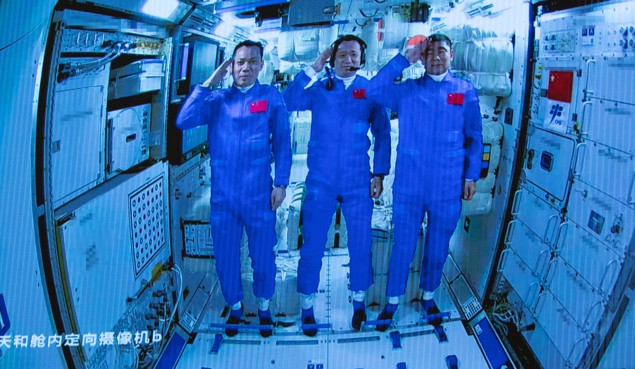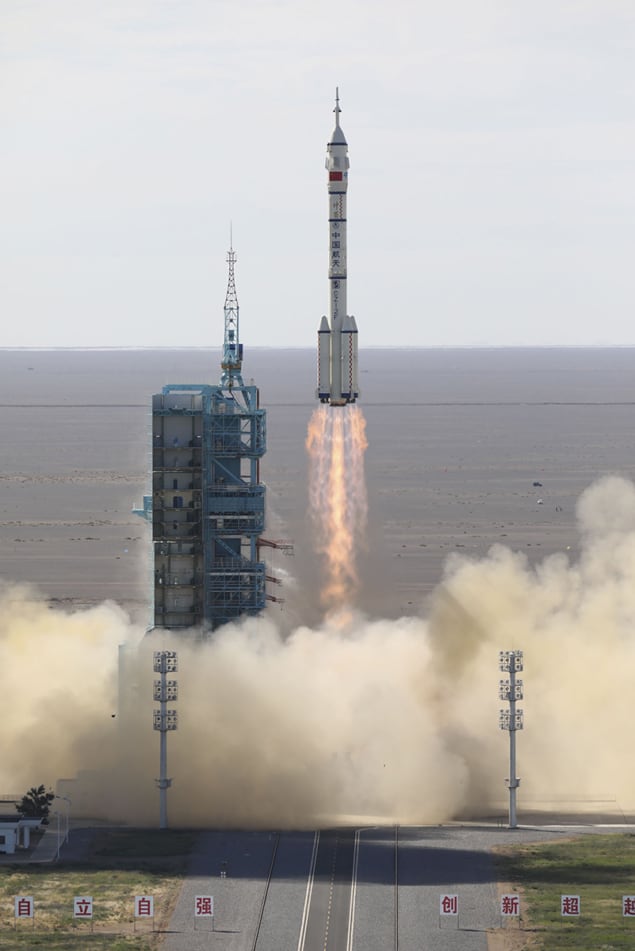With construction of its first dedicated space station set to be complete next year, China is now firmly becoming a major space power, as Ling Xin reports

At precisely 07:54 UTC on 17 June 2021, China passed the latest milestone in its quest to become a global space power. It was then that China’s Shenzhou-12 spacecraft, which had lifted off from the Gobi Desert just hours earlier, docked with the core module of the China Space Station (CSS). The three astronauts – Haisheng Nie, Boming Liu and Hongbo Tang – quickly set to work setting up a new home in low-Earth orbit. As well as marking the start of the longest crewed mission in the country’s fledgling space history, the moment signalled China’s first continuous presence in space orbit.
When the 100 tonne CSS is completed by the end of 2022, this T-shaped structure, floating 400 km above the Earth, will consist of three main building blocks. At the centre of the CSS will be the 16 m-long Tianhe (“Harmony of the Heavens”) core module, while two 14 m-long experimental modules – Wentian (“Quest for the Heavens”) and Mengtian (“Dreaming of the Heavens”) – will be permanently docked to Tianhe on opposite sides. Launched in April, Tianhe can accommodate three astronauts at a time for stays of up to six months and has a robotic arm to monitor the space environment, as well as grab and put modules in place.
The three astronauts who arrived in June have already carried out tests and experiments. They even spoke briefly with Chinese president Xi Jinping, telling him how they had adapted quickly to their new surroundings. The astronauts’ activities were also widely covered in the Chinese media, ranging from details of their meals of rice dumplings and Kung Pao chicken to how they were sorting out some 160 packages that had arrived earlier with the cargo vessel, “Tianzhou-2”. In July the astronauts did their first space walk, during which they tested their Chinese-built spacesuits, installed a work platform on the space station’s robotic arm, and mounted a panoramic camera.
With the first crewed launch complete, a further eight launches will now be required for China to complete construction of the CSS. First up will be another cargo vessel flight to replenish the CSS, followed by another mission towards the end of the year carrying crew who will swap places with the current team. Next year will be even busier, with the launch of two experimental modules, two cargo missions, and two further crewed missions before the space station is finally complete.
Experiment focus
Throughout its lifetime, the CSS is expected to be home to thousands of scientific experiments, exploring microgravity effects, space medicine, fundamental physics and astronomy, among others. They will be placed on 14 “experiment racks” spread among the Tianhe, Wentian, and Mengtian modules. But the experiments are far from a Chinese-only affair. In 2019 the first batch of nine international experiments were selected in a partnership between the China Manned Space Agency and the United Nations Office for Outer Space Affairs (UNOOSA). “The collaboration shows that China is really trying to open up the possibility for everyone in the world to use the facility that China is developing,” UNOOSA director Simonetta Di Pippo told the Beijing-based Xinhua news agency in 2018.

Research will soon start on the two experiment racks on Tianhe. One rack will be used to conduct experiments in which metal and non-metal samples are electrostatically levitated in the “air”, heated with lasers to as high as 3000 °C and then cooled back down to allow their physical properties to be studied. These experiments could have industrial applications in everything from aeroplane engines to smartphone cameras. The “high-microgravity” rack, meanwhile, will feature a suspended experimental platform, in which vibrations from the space station are blocked out and the microgravity level reduced by 2–3 orders of magnitude to 10–7g to look for evidence of new physics.
As for the “two-phase system” experiment rack on Mengtian, it will be used for research concerning evaporation, condensation and other heat-transfer processes in a microgravity environment to develop smaller, more efficient cooling devices for spacecraft. “Chinese scientists started working on this subject in the 1970s, but it was mostly fundamental research,” says Liu Qiusheng, the rack’s chief scientist, from the Institute of Mechanics at the Chinese Academy of Sciences in Beijing. “[Now] our focus has shifted to the application side, and we are building the biggest rack of its kind on a space station.”
But work won’t just go on inside the CSS, with the surfaces of Wentian and Mengtian featuring more than 50 docking points to host external experiments too. One of them will be the Spectroscopic Investigation of Nebula Gas (SING) – an experiment jointly proposed by researchers from the Indian Institute of Astrophysics and the Institute of Astronomy of the Russian Academy of Sciences. Working in the ultraviolet waveband, SING will observe emission lines of several elements – including carbon, nitrogen and oxygen – from nebulae and interstellar gas in our galaxy and beyond to infer their temperature, density, abundance and pressure.
The door is now open to all new projects China wants to do in space
Jonathan McDowell
According to SING’s co-chief scientist Jayant Murthy, the probe is expected to cover excited regions (such as supernova remnants), cold areas (gas clouds) and the general interstellar space. “The entire payload will be built for about $50,000 – a fraction of the cost of most space missions,” says Murthy. His team is now completing the basic design and plans to get the payload manufactured in the next few months, before finishing assembly and calibration by October 2022 in time for delivery to the CSS at the end of 2022.
“The door is now open”
According to a recent article by Gu Yidong, chief scientist of the China Manned Space programme, the CSS is set to be the most “important research infrastructure” for China in low-Earth orbit before 2035 (Chinese Journal of Space Science 41 10). With a minimum 10-year lifespan, the CSS could end up being the only space station in operation if the International Space Station (ISS) retires, as intended, in the mid to late 2020s. The ISS has supported nearly 3000 experiments but is ageing and requires almost constant maintenance. John Logsdon, a space-policy expert from George Washington University in Washington DC, says that the construction of the CSS underlines the need for the US and its partners to decide on the future of the ISS – including whether it should be deorbited, continued or perhaps replaced by a station run by the private sector. Physics in China attempts to rise from the pandemic
Jonathan McDowell from the Harvard-Smithsonian Center for Astrophysics stresses that technological advancements from building the CSS will hugely benefit China’s space endeavours in the future. Indeed, China already has a long to-do list for future science-based exploration beyond Earth orbit. Chang’e-6, for example, aims to return samples from the Moon’s south pole, while Chang’e-7 will survey its south pole in detail and Chang’e-8 is a technological precursor for the construction of a permanent lunar research base. And following its recent successful landing on Mars, China is already planning a sample-return mission from the red planet by 2030. Missions to return samples from a near-Earth asteroid, visit Jupiter and explore the edge of the solar system are also in the pipeline.
“I’m very impressed by the scope of Chinese space exploration in both science and applications, and that China has now deployed operational systems in every aspect of space technology,” says McDowell. “The door is now open to all new projects China wants to do in space.”
China’s first major space telescope gathers pace

Inspired by the success of NASA’s Hubble Space Telescope and the Sloan Digital Sky Survey, China is set to soon launch the Xuntian (“Survey the Heavens”) telescope. It will map the sky from the same orbit as the China Space Station (see main text) and seek answers to fundamental questions about the universe such as how and why the expansion of the universe is accelerating and the nature of dark energy.
As China’s first space-based large-aperture optical telescope, Xuntian will be about the same size as Hubble but with 300 times the field of view. It will have five instruments, including a 2 m-aperture survey camera, a spectrograph and coronagraph. Collectively, the instruments will not only carry out imaging and spectroscopy, but also look for black holes, exoplanets and other objects. Unlike Europe’s Euclid craft or NASA’s Roman Space Telescope, however, Xuntian will have an “off-axis” mirror, allowing it to take better measurements of “weak” gravitational lensing. About 70% of observing time over its first decade will be focused on surveying the sky.
According to Hu Zhan from the National Astronomical Observatories, Chinese Academy of Sciences, who is leading the development of the telescope’s survey camera, Xuntian’s design has gone through major changes. When first approved in 2013, the plan was to mount the telescope on one of the CSS’s experimental modules. But when astronomers in China realized that the space station and its astronauts could hinder the telescope’s observations, they instead turned to the current “co-orbital” design, in which Xuntian will fly a distance away from the CSS. Still, Xuntian could be made to dock with the space station, which according to Zhan would “service the telescope and take advantage of human resources [on the CSS]”.
Zhan and colleagues are finalizing the design of Xuntian and have started building the telescope. They hope to launch the mission in late 2023 or early 2024 and to get the telescope operational later that year. Once Xuntian’s 10-year mission is over, it could be pushed into a higher Earth orbit to undertake new science. But things will not all be plain sailing. Apart from the fact that China has never built such a large space-based optical telescope before, Xuntian will face many technological hurdles. When the telescope approaches the space station, for example, rocket fuel could contaminate the telescope lens. “There are lessons from Hubble, and it’s tricky to fix the telescope without ruining it,” says Jonathan McDowell, an astrophysicist at the Harvard-Smithsonian Center for Astrophysics.



